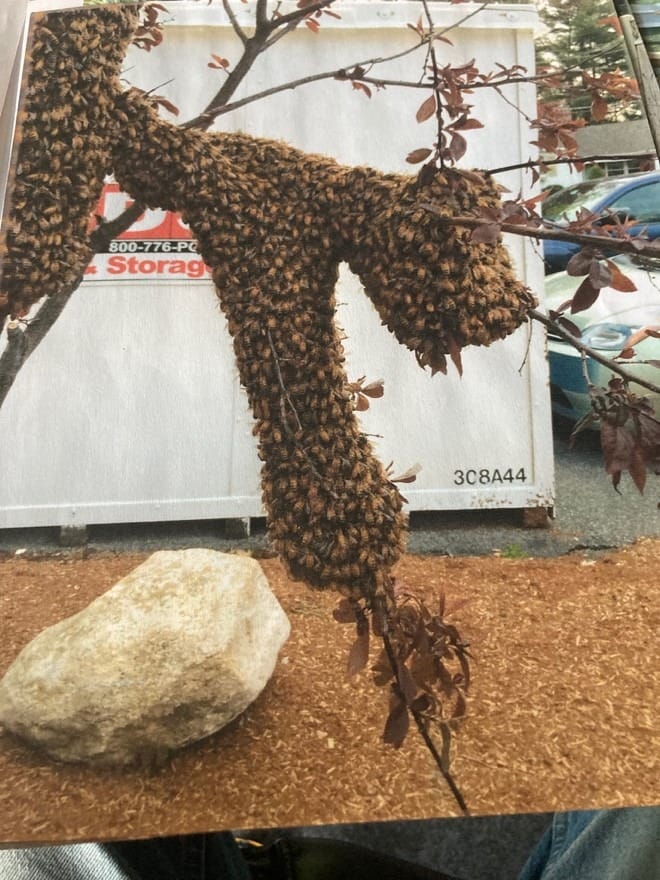Swarms and Binges: Survival Mechanisms of Honeybees
A look at how new honeybee hives are formed and how bees protect themselves during long periods without food, with columnist Bill Boivin

We’re all familiar with the idea of honeybee swarms, even if we’ve never seen one in person. But why do they form, how do they help with the survival of the species, and why would a beekeeper invite me into one? Find out in this month’s edition of Plants and Animals.
There are times, usually around May and June, when honeybee egg hatching is so successful, the hive gets overcrowded. At that point, the queen somehow indicates she is about to leave the hive. Then another remarkable thing happens – the hive produces a second queen! The original queen will then leave and ten to twenty thousand bees from the hive will follow her in a “swarm.” The swarm will collect in a mass on a tree branch nearby, protecting the queen while “scouts” go out and look for a suitable location to set up a new hive.
After a day or two, a scout returns and tells everyone, “Follow me!” and off they go to their new hive location. The original hive remains with its 10,000-20,000 complement, so now there are two hives.
I have witnessed swarms from my hives several times. The first time it happened, I heard a very loud buzzing and looked to see what it was. It was a swarm just leaving. The entire width of Boulder Drive was a curtain of 20,000 flying bees, from ground level to treetop. How overwhelmingly breathtaking!
Worrying about my neighbors or their kids walking down the street, I immediately called my beekeeper, Joel Govostes (Acacia Grove Honey Farm, Woburn MA) to ask what I should do. He said “Don’t panic, they will settle down in the next 10 or 15 minutes. Keep an eye on them and see where they land.”
Sure enough, they quickly congregated into a ball in a tree about 20 feet in the air. Joel arrived, hoping to capture the swarm with an empty hive box in the back of his pickup truck. He put a step ladder on the top of his truck cab and raised his bee-collection tool, a long pole ending in an open 5-gallon bucket. He wore no protective equipment.

He went up the ladder and stabbed the swarm repeatedly with the open bucket. He then dumped the bucket into the back of the truck and went up to get some more! After 4 or 5 buckets full, he leaned over the truck bed with its mass of thousands of flying bees. He explained that he was looking for the queen. If he could find her and get her to go into the empty hive box, the other bees would all follow.
I, of course, was watching all this from a safe distance. At one point he excitedly said “Bill, come look at this!” and beckoned me to walk through the swirling mass and look into the bed of the truck. Seeing my hesitation, he calmly told me it would be OK, the bees were physically unable to sting me at that time.
I chose to believe him – after all, how many chances in my life would I get to walk into a swarm of bees? So, I strode right over and stuck my head over the truck bed.
What a unique sensation to be inside a cloud of 20,000 flying bees! Kind of like in the movies when they show a person looking up the inside of a tornado…or a Sharknado (gasp!). Anyways, Joel pointed out the queen and a couple of drones and got the queen to walk into the box. At that point he took the box and set it on the ground in my side yard. He explained that the queen would not go anywhere, and the other bees would all join her. He said, “I’ll be back to pick up the box in two days.” It worked; he was successfully able to retrieve this swarm.
You probably ask why the bees would be unable to sting at that time. Excellent question! When bees plan to swarm away from the hive, they know it may be days before they relocate and begin honey production. They prepare for this potential fasting period by gorging themselves on honey, packing so much into their stomachs that they are no longer able to bend in the middle. That bending is essential to stinging, thus, too full to sting!
There is one other time that bees would stuff themselves in preparation for leaving: when they smell smoke! In the wild, smoke means forest fire and, likely, the need to evacuate. So, they gorge themselves in preparation. That is why beekeepers smoke the hive before maintenance activities. The bees all stick their heads into the honey and focus on flight preparation and don’t bother the intruder. Clever!
The smell of the smoke also masks the bees’ alarm pheromones. If one honeybee senses danger and stings a threatening animal, she releases a scent that warns the other bees of the danger. That will trigger many bees to rush out and attack the threat. That is why, if you get stung in the upper body, you should go inside and change your shirt to avoid becoming a major target.
Earlier this year, we talked about how bug species as a whole are able to survive the winter, even while individual insects don’t.
Bees and wasps are included in the list of insects that are still there in the spring, despite the winter’s freezing temperatures – although they use different methods to bring their species through to the new year.
A single wasp queen can start a new colony in the spring. Honeybees don’t work that way, though; their entire hive survives the winter – or that’s what’s supposed to happen, anyway.
Hive collapse unfortunately is very common in beekeeping. Nationwide, about half of all hives do not survive the winter. Most recent evidence points to a combination of factors as the culprit— “according to the USDA, these factors include parasites and pests, pathogens, poor nutrition, and sublethal exposure to pesticides”. So, Joel has to replace hives occasionally. He purchases a young queen from a supplier in Georgia; she comes with a supporting staff of about 10,000 bees. Placed into one of his empty hive boxes, the crew establishes itself into a viable hive in a few weeks; then he moves it to my yard. Purchasing queens costs money, so if he can get a free hive by capturing a swarm, that’s a good thing!
I lost both my hives over the past winter. Joel took one hive box away to use again. He cleaned one and left it in my yard. He explained, “It’s June, peak swarm season. I’m going to try a long shot. Supposedly, lemon grass oil can attract bees. I am putting a drop or two into this hive box. Let’s see what happens.” Two days later, a swarm moved in, and it’s been there all season. Crazy!
I have learned so much by having hives in my yard. It has been a fascinating glimpse into one of Mother Nature’s true wonders. Thank you Joel Govostes for the honey and the education, and thank you to the million or so honeybees that have passed through my yard in the last 10 years!
Bill Boivin is a scientist, retired from 30 years of active duty with the United States Public Health Service. He is a Burlington Town Meeting Member and Conservation Commissioner. He and his wife, Jane, grew up in Lynn and now live in Burlington with their 2 mini dachshunds, 7 chickens, and Maya, a ball python. Bill and Jane have shared a love of nature, gardening, and wildlife for over 50 years. They have fostered, healed, raised, and loved a remarkable variety of animals in their time together. Learn more about Bill.




